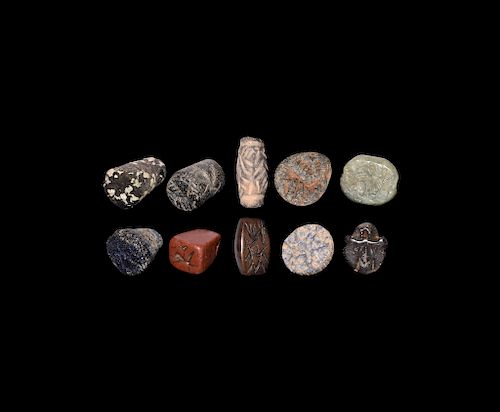Western Asiatic Stamp Seal Collection
Lot 409
About Seller
TimeLine Auctions Limited
The Court House, 363 Main Road
Harwick, Essex CO12 4DN
United Kingdom
Estimate:
GBP£800 - GBP£1,000
$1,000 - $1,250
Absentee vs Live bid
Two ways to bid:
- Leave a max absentee bid and the platform will bid on your behalf up to your maximum bid during the live auction.
- Bid live during the auction and your bids will be submitted real-time to the auctioneer.
Bid Increments
| Price | Bid Increment |
|---|---|
| GBP£0 | GBP£5 |
| GBP£100 | GBP£10 |
| GBP£200 | GBP£20 |
| GBP£500 | GBP£50 |
| GBP£1,000 | GBP£100 |
| GBP£2,000 | GBP£200 |
| GBP£5,000 | GBP£500 |
| GBP£10,000 | GBP£1,000 |
| GBP£20,000 | GBP£2,000 |
| GBP£50,000 | GBP£5,000 |
| GBP£100,000 | GBP£10,000 |
| GBP£250,000 | GBP£20,000 |
About Auction
By TimeLine Auctions Limited
Nov 23, 2018
Set Reminder
2018-11-23 05:00:00
2018-11-23 05:00:00
America/New_York
Bidsquare
Bidsquare : TimeLine Auctions London Mayfair Sale
https://www.bidsquare.com/auctions/timeline-auctions-limited/timeline-auctions-london-mayfair-sale-3572
Auction Venue: The May Fair Hotel London Stratton Street Mayfair London, W1J 8LT Viewing from noon Thursday 22nd Nov. 2018 Champagne Reception: 6pm - 9pm Friday 23rd Nov. 2018 (Day 1) 10am : Lots 1 - 660 TimeLine Auctions Limited enquiries@timelineauctions.com
Auction Venue: The May Fair Hotel London Stratton Street Mayfair London, W1J 8LT Viewing from noon Thursday 22nd Nov. 2018 Champagne Reception: 6pm - 9pm Friday 23rd Nov. 2018 (Day 1) 10am : Lots 1 - 660 TimeLine Auctions Limited enquiries@timelineauctions.com
- Lot Description
2nd-1st millennium BC. A group of ten seals including five accompanied by typed and signed notes by the late W.G. Lambert, Professor of Assyriology at the University of Birmingham 1970-1993, which state: (R-81) 'Stamp Seal of Red Stone, 10 x 12.5 x 17.5mm. This is pyramidal in shape, with flat oblong base, steeply rising sides, and a rounded tip, below which it is pierced. This design shows a standing quadruped, perhaps a horse, and a crescent above its back. the seal comes from west central Asia and dates to c. 1500-1000 b.C. It is worn, but the design remains clear.'; (U-193) 'Stamp-Cylinder Seal of Black Stone, 22 x 14mm. On the base there is a frieze of two such quadruped with a star over the back of one and a plant as a kind of terminal. This is a seal from ancient Urartu, c. 800-700 B.C. It has a nearly flat bottom and sides which flare in towards the top, where there are the remains of a broken loop. The surface is worn.'; (Q-53) 'Stamp Seal of Lapis Lazuli, 17 x 17 x 9mm. This has a round flat face with 'milled' edge, while the back is slightly convex with an arch-like loop on the back. The design consists of drill holes: a central star consisting of a central dot surrounded by a circle with six rays extending from it, and the six vacant spaces near the edge are filled with triangles of dots. This seal comes from west central Asia and dates to c. 2000-1500 B.C. it is in quite good condition.'; (T-605) 'Stamp Seal of Mottled Dark- and Light- Green Stone, 14 x 14 x 24.5mm. This is a tall conoid pierced close to the top. The convex face shows a bird, perching, with crescent in front and triangle behind. This comes from ancient Urartu and dates to c. 850-700 B.C. It is an interesting piece, but the surface is corroded.'; (R-784) 'Stamp Seal of Royal Blue Glass, 14 x 15 x 18mm. This is a conoid, pierced diagonally. The design on the convex face shows the kind, in a long robe with one leg projecting, standing with arms stretched out holding in each hand the top-knot of a rearing lion. There is a winged solar disc above the scene. This is an Achaemenid period seal from the eastern Mediterranean area, c. 450-350 B.C. For ancient glass it is in quite good condition.'; the rest comprising: one with elliptical plaque depicting a stag and hatched knop; one cylinder seal with concentric triangles; one tubular bead with flat surface to one side and design of two figures and two quadrupeds(?); one green stone tabular bead with lion attacking a horned quadruped; and a black stone amulet in the form of a frog pierced transversely with stamp to the base depicting a frog. 44 grams total, 16-25mm (3/4-1"). The Signo collection, the property of a West London businessman, formed in the late 1980s-early 1990s; collection numbers 2919, A-8, Q-53, R-81, R-784, T-605, V-111, V-193, Y-433, Y-997, academically researched and catalogued by the late Professor Lambert in the early 1990s. Dr. Bonewitz notes: 'The seals are made from lapis lazuli (1), jasper (2) serpentine (3), glass (2), limestone (2).' [10]Fine condition.
Condition
- Shipping Info
-
Buyer Pays Shipping Costs
-
- Buyer's Premium



 EUR
EUR CAD
CAD AUD
AUD GBP
GBP MXN
MXN HKD
HKD CNY
CNY MYR
MYR SEK
SEK SGD
SGD CHF
CHF THB
THB











